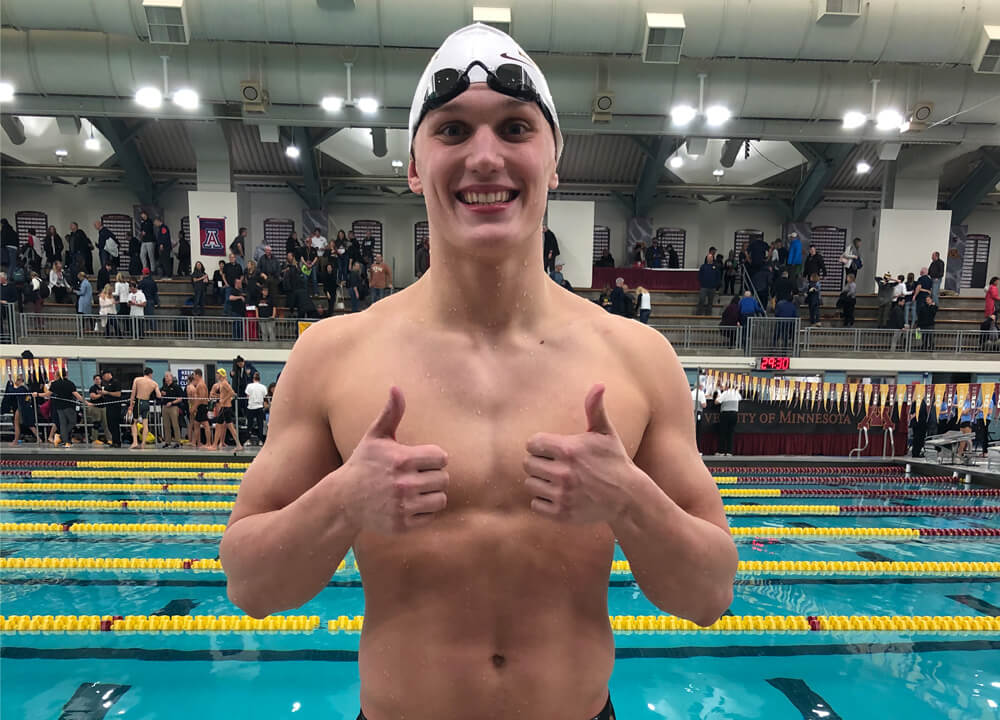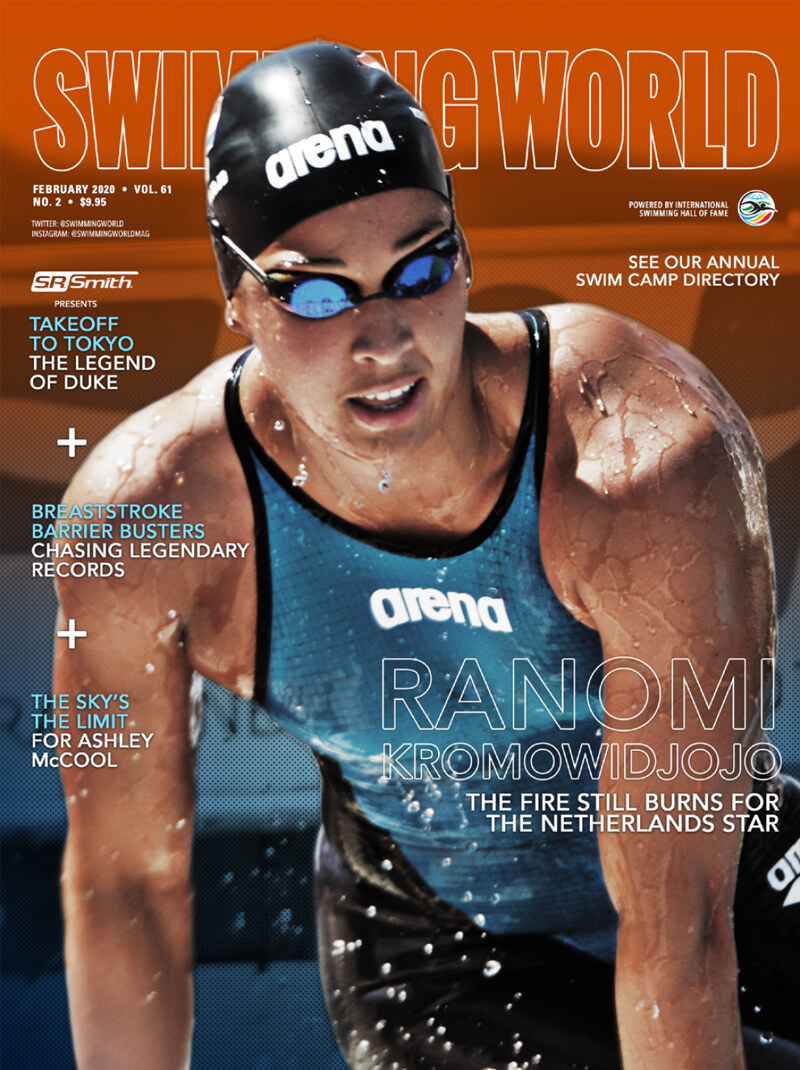Swimming World Presents “Learning From Adversity: Minnesota’s Max McHugh Perseveres After Drive-By Shooting”

Learning From Adversity:
Minnesota’s Max McHugh Perseveres After Drive-By Shooting
By David Rieder
Minnesota’s Max McHugh was involved in a drive-by shooting last summer, but he believes the incident has left him with a fresh perspective and gratitude for everyday things in life, including swimming. That approach has fueled his impressive return to the pool.
When Max McHugh arrived at the University of Minnesota, he was following older brother, Conner, who had previously been an All-American for the Golden Gophers. Very quickly, McHugh found himself in a situation where he could thrive in the pool.
Between his first Big Ten and NCAA Championships, McHugh dropped more than a second in the 100 yard breast to finish third nationally behind two seniors, his 50.30 making him the fourth-fastest performer in history. In the 200 breast, he swam a 1:49.41, dropping four seconds from his best time in becoming the sixth-fastest performer ever and finishing second behind another senior, Andrew Seliskar.
“I really think that coming in with the perspective of having nothing to lose—no expectations in the first year—just really helped me,” McHugh said. “I picked Minnesota partially because my brother was there before me. Just having him there was so helpful right away. If I ever had any questions, I could go to him. I attribute a lot of my success last year to him and just helping me out with everything.”
In short, he was the obvious candidate to emerge as the nation’s top breaststroker in Year 2.
But then, in late July, McHugh’s situation became a lot more complicated than just being a swimmer working toward further improvement. McHugh and Golden Gopher teammate Nick Saulnier were caught in a drive-by shooting in Minneapolis, a simple situation where the two had been in the wrong place at the wrong time.
One bullet hit McHugh, entering through his lower knee and exiting at the bottom of his quad. While he was otherwise unharmed, swimming suddenly took a backseat to two recovery processes, beginning with his physical recovery.
“I was very hesitant to start doing anything at first. I started on land for a couple weeks and then really gradually, very slowly and gradually, brought the yardage up in the pool. I started at maybe one practice a week and then up to two the next week,” McHugh said. “Just was careful with it.”
As he recovered, the lengthy recovery process wore on McHugh, particularly given that he had no control over how quickly he could return to normal swimming and normal life.
“PTSD was a huge thing. I lost a lot of sleep over it. It was a combination of a lot of things that made everyday things just a little more difficult,” he said. “Coach Kelly Kramer just kept ensuring me that in the long run, it’s going to help me just grow up a little bit quicker than everyone. Swimming, at that point, didn’t really matter. He just kept on ensuring me that, in the long run, we’re going to look back on it, and it’s going to be a huge growing point in my life.”
To read the full story of how Max got back in the water and pressed on with training,
Check out the February issue of Swimming World Magazine, available now!
Get Swimming World Magazine and Swimming World Biweekly FREE When You
Become A Member of the International Swimming Hall of Fame
Want More? Subscribe With This Special 2-Year Offer!
New! 1-Year Digital Only Subscription for just $39.95 Order Now!
Non-Subscribers Can Download This Issue For Only $5.94
017 BREASTSTROKE BARRIER BUSTERS
by David Rieder
The history of the men’s 100 and 200 yard breaststroke has included long stretches of chasing legendary records followed by a shorter period of continuous improvement.
019 LEARNING FROM ADVERSITY
by David Rieder
Minnesota’s Max McHugh was involved in a drive-by shooting last summer, but he believes the incident has left him with a fresh perspective and gratitude for everyday things in his life, including swimming. That approach has fueled his impressive return to the pool.
021 A SENSE OF DÉJÀ VU
by Dan D’Addona and David Rieder
Savannah College of Art and Design (NAIA women), Keiser University (NAIA men) and Indian River State College (NJCAA women and men) appear ready to show the swimming world something it has seen before: repeating as national team champions.
023 THE FIRE INSIDE STILL BURNS
by John Lohn
When discussing the best women’s sprint freestylers heading into this year’s Olympic Games, most frequently mentioned are Australia’s Cate Campbell, Sweden’s Sarah Sjostrom and the USA’s Simone Manuel. But don’t count out triple Olympic champion Ranomi Kromowidjojo of the Netherlands, who feels her best swims are still to come.
025 TAKEOFF TO TOKYO: DUKE
by John Lohn
As Swimming World continues its “Takeoff to Tokyo” series, a century has passed since Duke Kahanamoku last reigned over the water world, but his name—and merely his first name—remains synonymous with greatness in multiple ways.
027 THE SKY IS THE LIMIT
by Dan D’Addona
The future looks bright for junior diver Ashley McCool after transferring to the University of Florida.
COACHING
009 LESSONS WITH THE LEGENDS: CHARLES “RED” SILVIA
by Michael J. Stott
013 SWIMMING TECHNIQUE CONCEPTS: PLAN FOR A BREATHING PATTERN
by Rod Havriluk
Swimmers should plan a breathing pattern prior to each swim to gain the most benefit for both racing and training. The breathing pattern should limit head motion for better focus on technique and also provide sufficient oxygen for better performance.
015 POOR PERFORMANCE… THE NEXT STEP
by Michael J. Stott
At one time or another, disappointment haunts the dreams of even the best swimmers. And often it is the recovery from that disappointment that defines the athlete and, perhaps, the swimmer’s future.
030 SPECIAL SETS: GEORGE HAINES AT WORK
by Michael J. Stott
It never hurts to be a student of the sport. Sometimes that means visiting archival material, be it documents, voices, videos or all of the above to reacquaint ourselves with coaching legends and the methods that made them so effective. Here, Swimming World features the legendary George Haines.
043 Q&A WITH COACH ADAM HOYT
by Michael J. Stott
044 HOW THEY TRAIN ROGER GU AND GRACE GOETCHEUS
by Michael J. Stott
TRAINING
012 DRYSIDE TRAINING: STROKE STRENGTH SERIES—BUTTERFLY
by J.R. Rosania
JUNIOR SWIMMER
040 GOLDMINDS: PARTNERING WITH PARENTS
by Wayne Goldsmith
A simple, but effective strategy for coaches to engage with, connect to and educate the parents of the swimmers on their team is through the development of a “Training Manual for Swimming Parents.”
046 UP & COMERS: ZURI FERGUSON
by Shoshanna Rutemiller
COLUMNS & SPECIAL SECTIONS
007 A VOICE FOR THE SPORT
008 BEYOND THE YARDS
033 2020 SWIM CAMP DIRECTORY
047 GUTTERTALK
048 PARTING SHOT




